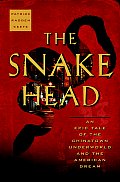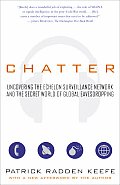
One day in the spring of 2008, I took a taxi to the airport in Hong Kong and filed onto a Dragon Air flight bound for Fuzhou, the regional capital of Fujian Province, a thin sliver of coastline in southeast China that sits across the strait from Taiwan. Fuzhou doesn't tend to feature in tourist itineraries of China. Many Americans have never heard of the city. But as it happens, the vast majority of Chinese immigrants who have come to the United States over the past three decades originate from this one tiny corner of the country. In fact, Fuzhou and the surrounding area have become a kind of "Little America," where everyone has family in the United States, and some villages have completely emptied out — the shops closed and the houses boarded up, because everyone is living and working abroad. The only people left in town are the grandparents, and the American-born babies of the young Fujianese immigrants who left the country. By virtue of being born on U.S. soil those children are legal American citizens, even if their parents are not. The parents are often working so hard in the United States that they don't have time to care for them, so shortly after the babies are born, they send them back to China to be raised by their grandparents. As I took my seat on the plane I noticed that almost everyone boarding around me had a baby or a toddler in tow. And most of these kids had something that their chaperones lacked: a U.S. passport.
Welcome to the bizarre dynamics of global migration today.
Several years before that flight to Fuzhou, I was living in New York City, having just finished law school. I was supposed to spend the summer studying for the bar exam, but I kept getting distracted by a sensational trial that was underway in a courtroom downtown. A notorious Fujianese human smuggler, or "snakehead," known as Sister Ping was facing charges of having operated a massive criminal network that smuggled untold numbers of people from China to Chinatown. The trial was absurdly colorful, full of roguish characters and noirish twists: there were smugglers and gangsters, shakedowns and stings, FBI wiretaps and confidential informants. Sister Ping emerged as a complex, contradictory character, a kind of Chinatown Don Corleone. While federal prosecutors described her as an arch villain who exploited her customers and sat atop "a conglomerate built upon misery and greed," in Chinatown she was revered as an immigrant success story and an altruistic local hero who helped thousands of people realize the American dream.
Much of the testimony revolved around a smuggling ship, the Golden Venture, which ran aground off of Queens, New York in the summer of 1993 with nearly three hundred undocumented Chinese immigrants in its hold. The snakeheads who had arranged the operation took the stand and recounted a story straight out of Robert Louis Stevenson or Alexandre Dumas: the ship had made a seventeen-thousand mile journey from Thailand. It had stopped in Kenya to take on Chinese passengers stranded there after a previous smuggling ship broke down. It almost capsized in a furious storm off the coast of South Africa, and there was an armed mutiny when the ship reached the mid-Atlantic. All told, the immigrants who arrived in America aboard the Golden Venture spent 120 days at sea — twice as long as it took the Pilgrims on the Mayflower to reach Plymouth Rock in 1620.
As I followed the trial this story took hold of me. It wasn't just the drama and sweep of the events. It was the cunning of the snakehead Sister Ping, who crafted a humble and inconspicuous persona in Chinatown even as she made an estimated $40 million smuggling her countrypeople to America, and who eventually led the FBI on a chase around the planet that would last six years. It was the extraordinary risks that the passengers on the Golden Venture were willing to undertake in order to reach the United States. And it was the difficult experience that those passengers confronted when they arrived here. As the ship ran aground, the passengers were told to jump overboard, that if they could set foot in America, the country's generous asylum policies would allow them to stay here. But the sea was stormy and the water was cold. Many of the passengers couldn't swim, and they were malnourished after months at sea. Ten died on the beach that day. And the rest were not granted asylum — but thrown into prison, where many of them remained for the next four years.
I tend to gravitate to thorny issues, conflicted areas of contemporary life in which the answers are not as simple as they might at first appear. My first book, Chatter, dealt with eavesdropping and surveillance by government agencies and the tricky balance between national security and civil liberties. I found myself drawn to the story of Sister Ping and the Golden Venture in part because the underlying issues — about why people come illegally to America and what should happen to them when they get here — are so difficult. Few people would be interested in reading a dry treatise about immigration policy, I figured, and really, I wasn't very interested in writing one. But it might be possible to use the story of Sister Ping, her undocumented customers, the gangsters she worked with, and the FBI investigation that eventually brought her down, to explore a series of deeper questions about illegal immigration today.
 By some fluke I ended up passing the bar exam, but by that time I had already decided to write a book about the saga of Sister Ping and the Golden Venture. One thing I noticed from the start was that the immigration debate tends to be long on argument and short on facts. By most estimates some twelve million illegal immigrants live in the United States today. But that's just an estimate. Nobody really knows. Nor does anyone have a firm grasp of the numbers of immigrants who continue to arrive illegally on planes, on boats, or on foot each day. Researching illicit, underground economies is difficult work, for understandable reasons: smugglers and illegal immigrants are reluctant to talk with journalists, academics, or policymakers. As a result we have only the dimmest understanding of the day-to-day lives of the huge population of undocumented people living in this country — why they leave their countries, how they manage to get here, what they do for work, and how they send money home. As I set out to write The Snakehead, I began tracking down the passengers from the Golden Venture. My aim was to tell the story not only of the FBI agents and White House officials and immigration officers who had been involved in the Golden Venture incident and the subsequent investigations, but to try to understand the motiations and the experiences of the undocumented immigrants themselves.
By some fluke I ended up passing the bar exam, but by that time I had already decided to write a book about the saga of Sister Ping and the Golden Venture. One thing I noticed from the start was that the immigration debate tends to be long on argument and short on facts. By most estimates some twelve million illegal immigrants live in the United States today. But that's just an estimate. Nobody really knows. Nor does anyone have a firm grasp of the numbers of immigrants who continue to arrive illegally on planes, on boats, or on foot each day. Researching illicit, underground economies is difficult work, for understandable reasons: smugglers and illegal immigrants are reluctant to talk with journalists, academics, or policymakers. As a result we have only the dimmest understanding of the day-to-day lives of the huge population of undocumented people living in this country — why they leave their countries, how they manage to get here, what they do for work, and how they send money home. As I set out to write The Snakehead, I began tracking down the passengers from the Golden Venture. My aim was to tell the story not only of the FBI agents and White House officials and immigration officers who had been involved in the Golden Venture incident and the subsequent investigations, but to try to understand the motiations and the experiences of the undocumented immigrants themselves.
What I found was an extensive shadow economy which ushered immigrants around the planet to New York City. Nobody knows how many people Sister Ping and other snakeheads smuggled from Fujian Province, but the CIA estimated that by the mid-1990s, the snakeheads were bringing 100,000 illegal Chinese immigrants each year. Nor did Sister Ping simply smuggle people into the country. Once they got here, her customers would work to send money home to their families in China, and she set up an underground bank to handle these remittances. She was faster and cheaper than Western Union, and the business became enormously successful. I was intrigued by the elaborate enterprises that had been established to cater to the undocumented community, and impressed by the sheer entrepreneurial acumen of Sister Ping.
But I was also fascinated by the immigrants I met. I got to know a young man named Sean Chen, who was forced to leave his home in Fujian Province when he was still a teenager, after he clashed with a local Communist Party official. Sean had little money, no passport or any other form of ID, and only the vaguest notion of what America was like. But he believed that he could start over here, live freely without fear of the government, and work hard enough to make some money to support his family. He trekked through the jungle covered mountains of Burma and into the dangerous Golden Triangle, crossing into Thailand, hiding out in Bangkok, and boarding a ship that took him as far as Mombasa, Kenya, before breaking down. After six months stranded in Kenya, Sean boarded the Golden Venture. He survived the voyage, and the subsequent years in jail, and through it all his devotion to the idea of building a life in America was so unwavering that he never wondered whether perhaps the whole adventure had been a terrible mistake. Today Sean lives in Philadelphia. He owns a house and he and his wife have an American-born son. But he's still not a legal resident of the United States. Sixteen years after arriving in America, and over a decade since his release from jail, he could still be deported any day.
No matter where you fall, or think you fall, on questions of illegal immigration, it is hard not to be impressed by the sheer tenacity of a character like Sean Chen. In our many conversations there were moments when I simply listened, open-mouthed, to the sacrifices he has made, and wondered whether in a similar position I would be brave enough to do the same. The Snakehead is a story about crime, about the rise and fall of the criminal empire of Sister Ping and about the dogged federal agents who spent over a decade chasing her around the world. In that sense, it's a thriller, and, I hope, an entertaining read. But it is also, on a deeper level, an exploration of what the American dream means to those who come from other shores and choose to live and work illegally in the United States, of the enormous risks that they undertake to come to this country, and of the price they pay to stay here.